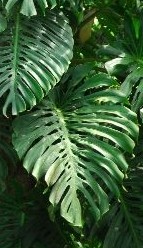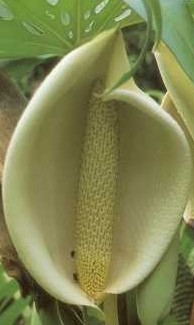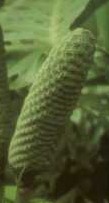 This evergreen liana is a native of the tropical jungle from southern Mexico to Panama and is a member of the arum family (Araceae) that includes jack-in-the-pulpits, peace lilies, and skunk cabbage. It goes by a variety of names including windowleaf, split-leaf philodendron, and Mexican breadfruit. The plant has a thick stem that is supported by aerial roots that attach themselves to both the ground and the stems and trunks of the forest canopy as they climb. In the wild plants can grow up to 100 feet long. The young leaves are heart shaped, leathery and glossy, lack holes, and lie close to their support. As they mature they grow to over 35” long, become perforated and divided, and stand away from their support. The inflorescence is a fleshy upright spadix covered with small creamy white flowers and is surrounded by a white bract (spathe). The spadix takes about a year to mature into an edible fruit (ceriman) that resembles a small green corncob with a sweet fruity taste reminiscent of pineapple. The plant is usually grown as a houseplant because it is so tender and is tolerant of low humidity and shade but if grown in the plenty of light can be magnificent. Only outdoor plants will flower and produce fruit. If grown indoors and taken out to the garden for the summer be sure to harden the plant by gradually moving it into a sunny position to avoid leaf scorch.
This evergreen liana is a native of the tropical jungle from southern Mexico to Panama and is a member of the arum family (Araceae) that includes jack-in-the-pulpits, peace lilies, and skunk cabbage. It goes by a variety of names including windowleaf, split-leaf philodendron, and Mexican breadfruit. The plant has a thick stem that is supported by aerial roots that attach themselves to both the ground and the stems and trunks of the forest canopy as they climb. In the wild plants can grow up to 100 feet long. The young leaves are heart shaped, leathery and glossy, lack holes, and lie close to their support. As they mature they grow to over 35” long, become perforated and divided, and stand away from their support. The inflorescence is a fleshy upright spadix covered with small creamy white flowers and is surrounded by a white bract (spathe). The spadix takes about a year to mature into an edible fruit (ceriman) that resembles a small green corncob with a sweet fruity taste reminiscent of pineapple. The plant is usually grown as a houseplant because it is so tender and is tolerant of low humidity and shade but if grown in the plenty of light can be magnificent. Only outdoor plants will flower and produce fruit. If grown indoors and taken out to the garden for the summer be sure to harden the plant by gradually moving it into a sunny position to avoid leaf scorch.

Type: Evergreen liana
Bloom: Spadix with small creamy white flowers surrounded by a white spathe
Foliage: Mature leaves leathery, glossy, perforated, split, and over 35” long
Size: Up to 100’ length
Light: Part shade to full shade
Soil: Fertile, moist, well-drained
Fertilizer: Liquid fertilizer every two weeks
Hardiness: Zones: 10-11
Care: Provide support for climbing such as a gazebo outdoors or a moss column indoors; wipe dust off leaves of indoor plants; mist indoor plants

Pests and Diseases: None of significance
Propagation: Seed, cuttings, aerial layering